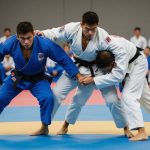Importance of Strength Training Optimization
Enhancing strength training through optimization offers numerous benefits for overall fitness. This method is not just about increasing muscle mass; it’s about achieving a harmonious balance that enhances strength, endurance, and flexibility. By focusing on performance optimization, athletes can improve their efficiency and effectiveness drastically.
Performance optimization involves tailoring a workout routine to the individual’s needs, focusing on maximizing output while minimizing wasted effort. This is achieved by fine-tuning variables such as exercise selection, repetition range, and rest intervals. When done correctly, this strategy boosts not only physical but also mental resilience, creating an ideal environment for progress.
Also to discover : How Electrode Placement in EMS Training Influences Targeted Muscle Groups
Understanding the impact of training efficiency is crucial. Efficient training reduces the time spent while maximizing results, which is a key factor in sustaining long-term commitment to fitness goals. It allows individuals to gain more benefits in less time, which is especially advantageous for those with busy lifestyles.
In summary, harnessing the power of strength training optimization leads to greater achievements in fitness endeavors. By focusing on both performance optimization and training efficiency, individuals can ensure that their efforts are directed towards achieving the best possible outcome.
In the same genre : Integrating Electro-Stimulation Therapy: Revolutionize Your Strength Training Regimen
Periodization Strategies
When it comes to strength training, periodization plays a pivotal role in structuring workouts for optimal results. Periodization involves dividing a training program into distinct phases, or training phases, each with specific objectives. This strategy helps athletes achieve continued progress while minimizing the risk of overtraining or plateauing.
There are several models of periodization to consider, each offering unique benefits. The linear periodization model involves gradually increasing intensity while decreasing volume over time. This approach is straightforward and suits beginners aiming to build foundational strength. On the other hand, the undulating periodization model varies intensity and volume consistently, which can be particularly beneficial for experienced lifters needing to break through plateaus.
To maximize results, it is essential to align individual fitness goals with appropriate training cycle duration. Short cycles may prioritize muscle endurance or hypertrophy, while longer cycles could focus on building maximum strength or power. Understanding the rationale behind periodization models and their impact on training efficacy empowers athletes to tailor their workouts to their specific needs and objectives. Whether aiming for increased muscle size or enhanced athletic performance, selecting the right periodization strategy aligns training efforts efficiently with desired outcomes.
Exercise Selection Techniques
Selecting the right exercises is crucial for achieving specific fitness goals. Understanding the criteria for exercise selection involves aligning workouts with your objectives. Whether you’re aiming to build muscle, improve endurance, or boost strength, the exercises chosen should reflect these goals.
Compound movements form a pivotal component of any strength-training regimen. These exercises, which include squats, deadlifts, and bench presses, engage multiple target muscles and joints simultaneously, offering maximum efficiency. They not only aid in building strength but also enhance coordination and balance, which are essential for overall fitness.
To maintain progress and avoid performance plateaus, it’s important to integrate accessory exercises. These exercises target smaller muscle groups and are performed alongside compound movements. Mixing in these exercises strategically can help address muscle imbalances and support joint health.
Consider these techniques:
- Start with compound exercises to condition large muscle groups.
- Incorporate specific accessory exercises to focus on weaker muscles.
- Regularly reassess your exercise selection to adapt to evolving goals and prevent monotony.
By following these guidelines, you can create a balanced workout plan that maximizes effectiveness and efficiency in your exercise selection.
Recovery Techniques
Muscle recovery is an essential component of any fitness routine, enabling optimal performance and injury prevention. Active recovery methods, such as low-intensity exercises like walking or cycling, help maintain blood flow to muscles without exerting them too much, aiding in effective muscle recovery. Incorporating rest days is equally important; allowing your body to recuperate and repair ensures long-term progress.
Sleep and nutrition play significant roles in recovery strategies. Adequate sleep facilitates the release of growth hormone, crucial for muscle repair and rebuilding. A balanced diet, rich in proteins and healthy fats, supports tissue regeneration and energy restoration. Ensuring your intake of essential nutrients optimizes the recovery process.
Several techniques can enhance muscle recovery. Foam rolling helps release muscle tension and increase flexibility, complementing the recovery strategies perfectly. Stretching post-exercise promotes range of motion and reduces stiffness, making it indispensable for muscle recovery. Massage therapy can further aid relaxation by improving circulation and reducing muscle soreness.
Incorporating a combination of these recovery methods, alongside proper sleep and nutrition, can lead to a more effective and comprehensive recovery strategy, ultimately benefiting your overall fitness.
Nutrition Advice
Understanding how nutrition plays a role in fueling performance is essential for anyone engaged in strength training. The right balance of macronutrients—proteins, carbohydrates, and fats—supports muscle growth and repair. Proteins supply amino acids necessary for muscle development; an ideal intake is around 1.6 to 2.2 grams per kilogram of body weight per day. Carbohydrates act as the primary energy source, replenishing glycogen stores that get depleted during resistance training. Meanwhile, healthy fats support overall cellular function and hormone production.
Timing your nutrition around workouts is crucial for optimal results. Consuming a meal rich in carbohydrates and protein about 2-3 hours before training can enhance performance. Post-workout meals should focus on proteins and carbohydrates to facilitate recovery and muscle synthesis. Aim for around 20-40 grams of protein and 30-100 grams of carbohydrates post-exercise, depending on your specific needs and goals.
Supplements like creatine and whey protein can be considered for enhanced performance. Creatine provides the muscles with additional energy during high-intensity training, while whey protein offers a convenient way to meet your daily protein intake. Always consult a healthcare provider before adding supplements to your routine.
Mental Preparation for Training
The significance of mental preparation in strength training cannot be overstressed. A well-prepared mind is just as crucial as a strong body. It serves as the foundation for a successful and sustainable training regimen, facilitating enhanced physical performance. Mental readiness is a vital component of a comprehensive fitness plan, enabling individuals to overcome obstacles and push their limits.
Developing a robust training mindset involves employing several techniques. One effective method is visualization, where athletes mentally rehearse their workouts, envisioning themselves achieving their goals. This process can increase motivation and improve focus, setting the stage for actual performance enhancement. Another key strategy is goal setting, which provides direction and fosters a sense of purpose. Setting clear, attainable objectives encourages individuals to stay committed and track progress over time.
Performance enhancement is closely linked to mental fortitude. By cultivating a strong training mindset, athletes can reduce anxiety and build resilience, crucial for overcoming challenging workouts. Establishing a positive mental attitude is essential, as it not only boosts confidence but also enhances the overall training experience. Understanding and implementing these strategies can significantly contribute to more effective, goal-oriented strength training sessions.
Real-life Examples and Success Stories
Real-life examples illustrate the power of effective training strategies in the world of sports and fitness. Case studies of athletes demonstrate how they’ve transformed their routines to achieve new heights. A prime example includes a marathon runner who incorporated interval training and cross-training into her regimen. This adjustment not only improved her endurance but also reduced the risk of injuries, enabling her to achieve personal bests.
Furthermore, a fitness enthusiast might adopt strategies from these individuals’ stories. Lessons learned, such as balancing rest with high-intensity workouts, highlight the importance of listening to one’s body. These success stories reinforce that effective training revolves around customization and consistency.
Real-life applications of these strategies have universal appeal. Whether applying them to sports performance or personal fitness goals, the main takeaway is the ability to adapt and improve. Emulating successful athletes by experimenting with varied workout intensities, nutrition plans, and mental toughness development can result in significant progress. Thus, these success stories serve as both inspiration and a practical guide for those seeking to optimize their performance.











